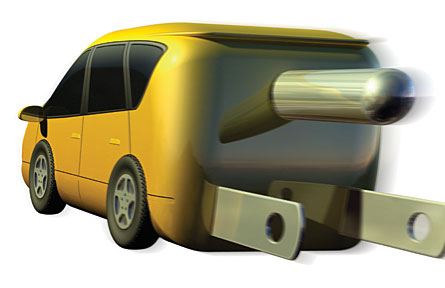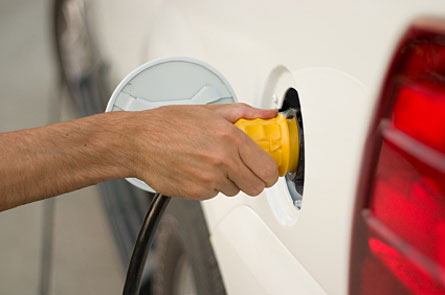Ready, unplug, drive
Plug-in hybrid cars, coming within a few years, will help save gasoline
By Emily Sohn
 |
|
Plug-in hybrid cars run on both gasoline and batteries, an energy combination that would let drivers travel longer without refueling.
|
| EPRI Journal |
When a handheld video game runs out of juice, all you have to do is plug it in and charge it up. Within a few years, some of you might do the same thing with mom’s car.
Automobile companies are developing vehicles that will plug in to electric sockets, just like many laptops, digital cameras, cell phones and small video-game players do. Called “plug-in hybrids,” these cars will get
most of their power from electricity. Their drivers will rarely have to stop at gas stations.
The technology is more than just gee-whiz cool. In our automobile-filled world, plug-in vehicles could reduce the amount of gasoline our nation uses. That gas is made from crude oil, which has been skyrocketing in
cost. Much of our oil also comes from countries overseas where wars and other unrest make supplies uncertain. So plug-in hybrids could both save both money and lessen the nation’s dependence on overseas energy supplies. Plus, motoring around in these hybrids may even help the environment.
“Plug-in hybrids are a promising automotive powertrain option for the 21st century,” says Dan Santini. He’s a transportation economist at Argonne National Laboratory, a government research center run by the U.S. Department of Energy.
The first company-produced plug-in hybrids could hit the roads by 2010.
But plug-in hybrids aren’t a cure-all for energy problems. Some experts say that replacing gasoline with electricity (much of it generated by
burning coal) might simply swap one type of environmental strain for another.
And engineers still have a lot of work to do to make plug-in hybrids practical and inexpensive. Researchers need to figure out what kind of
technologies will work best and how much people will be willing to pay for the cars, among other questions.
“The answers don’t exist yet,” says Ted Bohn, an electrical engineer at Argonne, near Chicago. “As a kid I thought someone someplace knows the answer to everything. All of these questions haven’t been decided. That’s what engineering is about — making a guess, running tests and fine-tuning assumptions.”
Out of gas
In many places, people depend on their cars and trucks to get everywhere — from school and work to the grocery store or doctor. And most
automobiles today get their vroom from gasoline. It produces enough energy to power the engine, turn the wheels and make the car go.
Burning gas produces more than just energy, though. Gas-burning cars also produce a lot of carbon dioxide, a type of greenhouse gas. These gases accumulate in the atmosphere, where they trap heat and fuel
global warming.
 |
|
Recharging the batteries in a plug-in hybrid car would be similar to recharging the batteries in an all-electric (no gas) car, shown here.
|
| gchutka / iStockphoto |
Gasoline is also getting more expensive — and prices at pumps
throughout the United States surged to record highs this past summer. Reasons for the rise are complicated, but the trend is leading many people to look for alternatives to gasoline.
Hybrid vehicles are one solution. Introduced in the late 1990s, hybrid cars get power from a combination of electricity and gasoline. At times, such as when driving on the highway, they run like regular gas-powered cars. But hybrids also have a special type of rechargeable battery and an
electric motor, which allow them to sometimes drive with the engine off. With the engine off, the car uses no gasoline.
As a result, hybrids can go more miles on less gas. For example, the newest model of the Toyota Prius, the most widely purchased kind of hybrid in America, gets an average of 46 miles per gallon, according to the website www.fueleconomy.gov. By comparison, the gas-powered Toyota Camry, a similar-sized car, gets about 26 mpg on average.
Plug-in hybrids will go a step further. On a full charge, they’ll be able to drive up to 40 miles without using any gasoline at all, Bohn says. Surveys show that nearly 80 percent of Americans drive fewer than 20 miles a day. So people who only drive short distances could, in theory, recharge
their cars every night and not refill the gas tank—for years! During longer
trips, plug-in hybrids will work like regular hybrids, with a gas-powered
engine that recharges the battery.
On average, a typical plug-in hybrid driver would get an estimated 150 miles per gallon. Sounds like the perfect way to save money on gas, right? And you might even help to save the planet from pollution.
Perhaps, but scientists still have some kinks to work out.
The Weak Link
Batteries pose the biggest challenge. A standard gas-powered car uses something called a lead-acid battery. These devices are fairly cheap and they last a long time. But lead-acid batteries are also extremely heavy.
You also have to run the engine regularly to keep them charged. And they are only strong enough to power the car’s lights and other electronic equipment.
In a hybrid vehicle, batteries must store much more energy — enough to actually run the car with the engine off. It would take many, many lead-acid car batteries to do the job, Bohn says. In fact, so many that batteries would take up half of the car.
Instead, most hybrid cars use nickel-metal-hydride batteries. They’re lighter, more efficient and quicker to charge than lead-acid batteries. They are also more expensive, which helps explain why hybrids cost
thousands of dollars more than gas-powered cars the same size.
Batteries for plug-in hybrids need to be able to store even more energy than do those in typical hybrid cars. And that’s where scientists keep getting stuck — designing smaller, more powerful, long-lived and
lighter-weight batteries
Not surprisingly, Bohn says, “Battery research is very hot.”
In the plug-in-hybrid world, lithium-ion (Li-ion) batteries are getting the most attention. These batteries can store a large amount of energy in a small package, and they last a relatively long time between charges. Li-ion batteries are standard in laptops, cell phones, heart devices, power tools and similar portable devices.
Scientists have found ways to make Li-ion batteries — and the gadgets that contain them — smaller and sleeker in recent years. But because cars are so big and heavy, it would still require a suitcase-sized Li-ion battery to power about 8 miles of driving, Bohn says. It would take five of these mega-batteries to propel a car for 40 miles. What’s more, the batteries are extremely expensive.
“A car filled with batteries could go a long distance,” Bohn says. “But it couldn’t haul any people, and it would cost $100,000.”
Engineers continue to look for ways to shrink Li-ion batteries even more. In the meantime, companies that are designing plug-in vehicles are making lots of guesses about how much money people are willing to
spend on them, Bohn says. Batteries are central to those questions.
“As we speak, huge decisions are being made [by the automobile industry] about how big the battery should be,” he says. “The battery can be as expensive as the whole car.”
Drive for the environment
Several companies plan to release fleets of plug-in hybrids in the next few years. Still, it’ll probably be a while — if ever — before most people make the switch. One reason is that there simply aren’t enough Li-ion
batteries on the planet right now to produce enough plug-in cars for everyone, Bohn says.
In addition, these cars may not be a good choice for people without a garage to store their hybrid — and plug it in. The same would be true of
people who live in high-rises or apartment buildings. Where would these people plug in their cars? And for rural families, daily travels may far exceed the 40-mile range of plug-in hybrids. These people might be better off with the less-expensive, conventional hybrid vehicles.
There are environmental complications, too. One study last year found that if 60 percent or more of U.S. drivers switched to plug-in hybrids, the country would produce a third fewer greenhouse gasses. But most of the electricity that comes out of our wall sockets is produced by power plants
that burn coal, Bohn says. And burning coal produces pollution, just as burning gasoline does.
To get around that environmental dilemma, Bohn says, plug-in owners could someday choose to charge their cars in the middle of the night
instead of in the middle of the day. Thanks to the way the country’s energy system works, the timing would allow the car to get electricity created by wind power and other more Earth-friendly technologies.
In this way, drivers of the future might start to realize that, “My car is not just going to get me from point A to point B,” Bohn says. “It will help me make energy decisions.”







